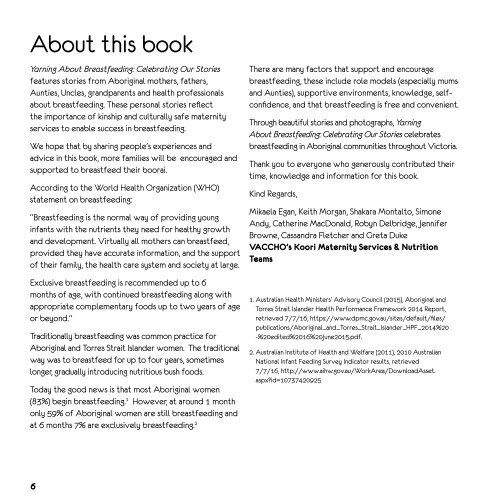Yarning about breastfeeding
VACCHO-BREASTFEEDING-WEB3
VACCHO-BREASTFEEDING-WEB3
You also want an ePaper? Increase the reach of your titles
YUMPU automatically turns print PDFs into web optimized ePapers that Google loves.
About this book<br />
<strong>Yarning</strong> About Breastfeeding: Celebrating Our Stories<br />
features stories from Aboriginal mothers, fathers,<br />
Aunties, Uncles, grandparents and health professionals<br />
<strong>about</strong> <strong>breastfeeding</strong>. These personal stories reflect<br />
the importance of kinship and culturally safe maternity<br />
services to enable success in <strong>breastfeeding</strong>.<br />
We hope that by sharing people’s experiences and<br />
advice in this book, more families will be encouraged and<br />
supported to breastfeed their boorai.<br />
According to the World Health Organization (WHO)<br />
statement on <strong>breastfeeding</strong>:<br />
“Breastfeeding is the normal way of providing young<br />
infants with the nutrients they need for healthy growth<br />
and development. Virtually all mothers can breastfeed,<br />
provided they have accurate information, and the support<br />
of their family, the health care system and society at large.<br />
Exclusive <strong>breastfeeding</strong> is recommended up to 6<br />
months of age, with continued <strong>breastfeeding</strong> along with<br />
appropriate complementary foods up to two years of age<br />
or beyond.”<br />
Traditionally <strong>breastfeeding</strong> was common practice for<br />
Aboriginal and Torres Strait Islander women. The traditional<br />
way was to breastfeed for up to four years, sometimes<br />
longer, gradually introducing nutritious bush foods.<br />
Today the good news is that most Aboriginal women<br />
(83%) begin <strong>breastfeeding</strong>. 1 However, at around 1 month<br />
only 59% of Aboriginal women are still <strong>breastfeeding</strong> and<br />
at 6 months 7% are exclusively <strong>breastfeeding</strong>. 2<br />
There are many factors that support and encourage<br />
<strong>breastfeeding</strong>, these include role models (especially mums<br />
and Aunties), supportive environments, knowledge, selfconfidence,<br />
and that <strong>breastfeeding</strong> is free and convenient.<br />
Through beautiful stories and photographs, <strong>Yarning</strong><br />
About Breastfeeding: Celebrating Our Stories celebrates<br />
<strong>breastfeeding</strong> in Aboriginal communities throughout Victoria.<br />
Thank you to everyone who generously contributed their<br />
time, knowledge and information for this book.<br />
Kind Regards,<br />
Mikaela Egan, Keith Morgan, Shakara Montalto, Simone<br />
Andy, Catherine MacDonald, Robyn Delbridge, Jennifer<br />
Browne, Cassandra Fletcher and Greta Duke<br />
VACCHO’s Koori Maternity Services & Nutrition<br />
Teams<br />
1. Australian Health Ministers’ Advisory Council (2015), Aboriginal and<br />
Torres Strait Islander Health Performance Framework 2014 Report,<br />
retrieved 7/7/16, https://www.dpmc.gov.au/sites/default/files/<br />
publications/Aboriginal_and_Torres_Strait_Islander_HPF_2014%20<br />
-%20edited%2016%20June2015.pdf.<br />
2. Australian Institute of Health and Welfare (2011), 2010 Australian<br />
National Infant Feeding Survey Indicator results, retrieved<br />
7/7/16, http://www.aihw.gov.au/WorkArea/DownloadAsset.<br />
aspx?id=10737420925<br />
6


